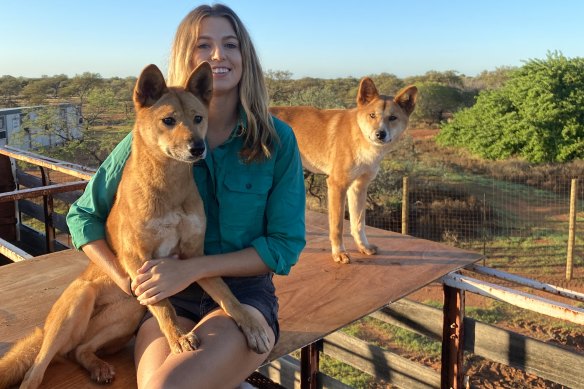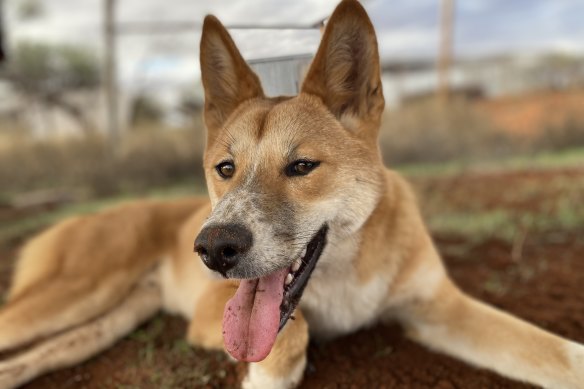By Emma Young
A few times while transporting his stressed and carsick new dingo pups 4500 kilometres across the country in a campervan, cattle farmer David Pollock could have been forgiven for wondering if he had bitten off more than he could chew.
But Steve and Eulalia are healthy, happy and a huge part of the ever-expanding Wooleen Station, which is now as much a tourist destination and sustainability case study as an agricultural operation.
Wooleen, halfway between Perth and Exmouth in the Murchison, is one of 285 stations in Western Australia’s Southern Rangelands.
But David and his wife Frances are set apart by their decade-long sustainability project publicising the degradation of these rangelands due to overgrazing through both overstocked cattle and by unmanaged and feral animals.
Since they have allowed wild dingoes to return to their property they have relieved grazing pressure on their land alongside like-minded farmers in NSW and Queensland.
This work attracted Zali Jestrimski, who had worked with the Australian Dingo Foundation in Victoria, and saw an opportunity to further her research.
“She was so passionate, and when we saw her resume it was a no-brainer,” Frances Pollock said.
Jestrimski began to give talks to visitors about the role dingoes played at Wooleen. And when back in Victoria for a visit, she became aware of a problem at the Australian Dingo Foundation.
Two dingo pups at the sanctuary, bred for the Adelaide Zoo, had been left homeless when the zoo ended up unable to take them.
Jestrimski suggested to the Pollocks that they turn their dingo talks into dingo encounters by providing a home and a job for the two eight-month-old pups.
“It was a big undertaking, but we decided it fitted with our mission and our values and the future of the rangelands,” Pollock said.

Zali Jestrimski at Wooleen Station with dingoes Eulalia and Steven.Credit: Wooleen Station
“So Dave went to Victoria.”
But the Pollocks were told that putting these timid puppies on a plane would traumatise them irreversibly, and the only ethical option was driving.
When they put Steve and Eulalia in crates in a campervan, they discovered the pups were prone to carsickness.
But at least they could be taken for walks when they got too stressed.
Bureaucracy turned out to be merely an export permit and an encounter with the Border Force – who were so excited all they wanted to know was if they could take pictures with Steve and Eulalia.
Registering and microchipping them with the local council was simple, as was spreading the word.
“We knew the community bush telegraph would take care of it,” Frances Pollock said.
Once out of the car, Steve and Eulalia settled down with their new large private enclosure and their “great big walks” from Jestrimski, who now runs the encounters in another special enclosure.
Tourists (adults only) wear neutral clothing and stay quiet and seated within the enclosure, with the dingoes choosing whether to come, go or interact.

Steven is the more sociable dingo, while Eulalia is shyer. Credit: Wooleen Station
“They’re a bit like a cat in a dog suit,” Pollock said.
“They don’t respond like a dog does, I couldn’t just go and call Steve and expect him to come. He might come and interact with me because he wants to.
“They can certainly be socialised and accustomed to humans, but they are still timid.
“Like any wild animal if they felt threatened they’d probably bite, but Zali’s very experienced with them, and we’ve never had any issues.”
Pollock said this experience also educated people about how to behave if they came upon a dingo in the wild – to minimise the perceived threat to a dingo and therefore minimise their personal risk.
Jestrimski’s talk also covers the role dingoes play in landscape management, dingo types (alpine, tropical and desert) and the physical differences between dingoes and dogs, with their different colours, joints, flexibility, and eye and ear shape and rotation.
“Steve is the one happiest to demonstrate these things, while Eulalia is shy,” Pollock said.
“After every single talk, half the people walk away saying they had no idea how much misinformation is out there.
“They feel empowered by knowledge about an animal we haven’t given a thought to.
“Predators don’t often get the spotlight, but they are important, and have their place and their story, and people can now have proper conversations about that.”
Start the day with a summary of the day’s most important and interesting stories, analysis and insights. Sign up for our Morning Edition newsletter.